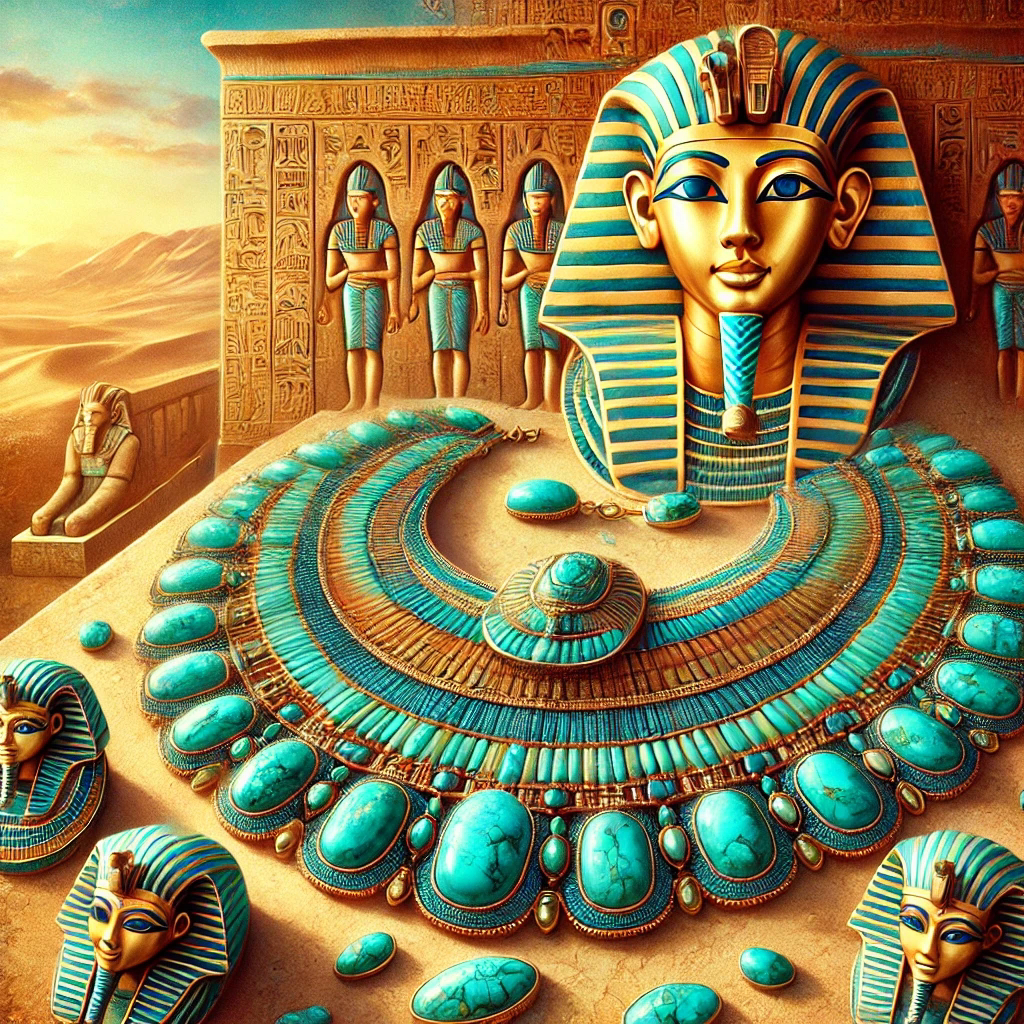Hi there, dreamers and deep thinkers!
Let’s dive into one of the most fascinating aspects of ancient Egyptian culture—their love affair with turquoise. This isn’t just a story about a pretty blue stone; it’s a tale of spirituality, power, and the human quest to connect with the divine. Buckle up, because we’re heading straight into the shimmering sands of history.
The Allure of Turquoise
Imagine walking along the streets of ancient Egypt thousands of years ago. The sun is blazing, the Nile is gently flowing, and you catch a glimpse of something mesmerizing—a vivid blue-green stone, set into jewelry, adorning temples, and even gracing the coffins of pharaohs. That’s turquoise, a gem so deeply woven into Egyptian life that it wasn’t just a luxury—it was a spiritual necessity.
Turquoise wasn’t merely admired for its beauty. The Egyptians saw it as a gift from the gods, a divine stone imbued with protection, vitality, and a connection to the eternal.
Mining the Treasure of the Sinai
The Egyptians called turquoise “mefkat”, which translates to “joy” and “delight.” Fitting, right? The primary source of this gem was the Sinai Peninsula, specifically in the arid regions known as Serabit el-Khadim and Wadi Maghareh. These mining sites were nothing short of sacred ground.
Now, mining turquoise wasn’t a casual day job. It was a royal endeavor. Expeditions to these mines were often led by priests or high-ranking officials, who saw the act as a spiritual mission. Offerings were made to Hathor, the goddess of love, joy, and motherhood, who was also revered as the “Lady of Turquoise.” This wasn’t just mining; it was a sacred ritual.
Hathor: The Goddess of Turquoise
Speaking of Hathor, let’s talk about her role in all this turquoise business. Hathor wasn’t just any goddess—she was the embodiment of life’s pleasures and protector of miners. Her image was often carved into turquoise amulets, symbolizing her guidance and blessings.
When miners headed to the harsh Sinai desert, they carried their devotion to Hathor like armor. Temples dedicated to her were built near the mines, where rituals were performed to ensure the safety and success of these expeditions. Even today, the ruins of these temples whisper stories of devotion and resilience.
Turquoise in Egyptian Jewelry
If you’ve ever seen an image of ancient Egyptian royalty, chances are you’ve noticed their exquisite jewelry. Turquoise was a staple in their adornments, often paired with gold, carnelian, and lapis lazuli. These weren’t just accessories—they were symbols of status, protection, and spiritual power.
One of the most iconic examples is the broad collar necklace, or “wesekh.” These collars were often inlaid with turquoise and worn by royalty and high priests. Why? Because turquoise was believed to hold the power of eternal life. Wearing it wasn’t just a fashion statement; it was a declaration of one’s connection to the divine.
The Protective Power of Turquoise
The Egyptians weren’t just about aesthetics; they believed in the stone’s protective properties. Turquoise amulets were carved into shapes like scarabs, the Eye of Horus, and other symbols of protection. These amulets were worn to ward off evil, bring good fortune, and even guide the soul in the afterlife.
Take the scarab beetle, for instance. A turquoise scarab wasn’t just a pretty trinket—it was a symbol of rebirth and transformation. Placed on mummies, it was meant to ensure safe passage into the afterlife. For the living, it served as a talisman against misfortune.
Turquoise in Funerary Practices
Let’s get a little morbid (in the best way possible). Turquoise played a significant role in ancient Egyptian funerary practices. It adorned the burial masks and coffins of the elite, including the legendary King Tutankhamun. His burial mask, famously inlaid with turquoise, symbolized his divine status and his journey to the afterlife.
Why turquoise? The Egyptians associated its blue-green hue with the heavens, the Nile, and the lush vegetation of life. It was a reminder that life and death were interconnected—a seamless cycle under the watchful eyes of the gods.
The Symbolism of Color: Why Blue-Green?
Colors carried profound meanings in ancient Egyptian culture, and turquoise’s blue-green shade was particularly significant. Blue symbolized the sky, water, and the divine, while green represented fertility, growth, and renewal. Together, these hues encapsulated the essence of life itself.
Turquoise was a bridge—a link between the mortal world and the divine realm. When an Egyptian wore turquoise, they weren’t just accessorizing; they were aligning themselves with the forces of life, creation, and eternity.
The Legacy of Turquoise Today
Fast forward to today, and turquoise still holds a special place in our hearts and cultures. While the ancient Egyptians might not have had Instagram, they understood the timeless appeal of this gem. Its use in their art, jewelry, and spiritual practices has inspired countless civilizations, from the Native Americans to modern jewelry designers.
But perhaps the most lasting legacy of turquoise lies in its message. It reminds us that beauty is more than skin deep—that it carries stories, beliefs, and connections that transcend time.
Final Thoughts
So, what can we learn from the ancient Egyptians and their love for turquoise? Perhaps it’s this: In a world where everything seems fleeting, there’s a deep longing for connection—to the divine, to nature, and to one another. Turquoise, with its vibrant hues and rich history, was more than a stone; it was a symbol of hope, protection, and the eternal.
And maybe, just maybe, that’s why we’re still drawn to it today. Its beauty speaks to something timeless within us—a reminder that, like the Egyptians believed, we’re all part of something eternal and interconnected.
Stay curious.




